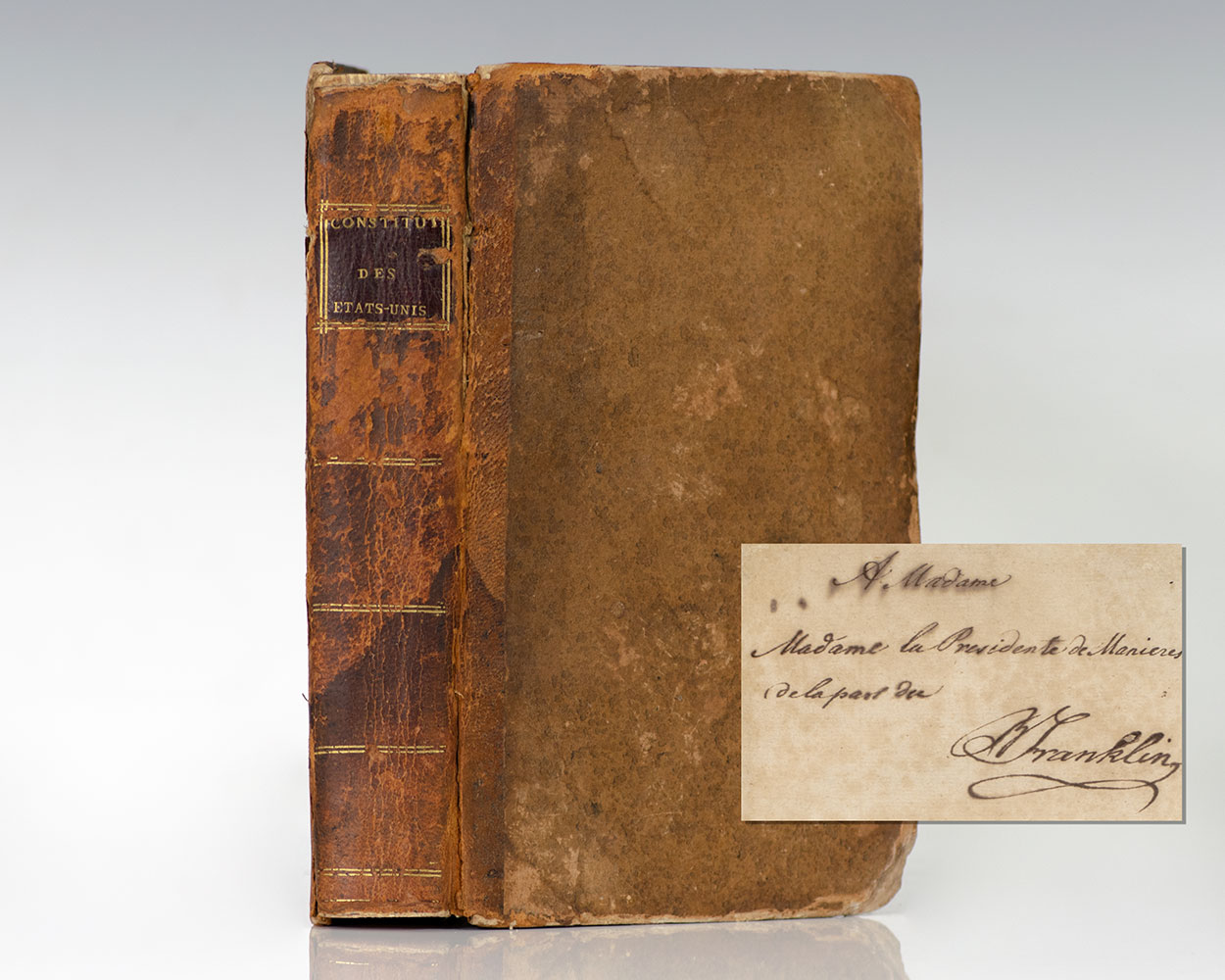Experiments and Observations on Electricity, Made at Philadelphia in America, by Benjamin Franklin, L.L.D. and F.R.S. To which are added, Letters and Papers on Philosophical Subjects. The Whole corrected, methodized, improved, and now first collected into one Volume, and Illustrated with Copper Plates.
Exceptionally rare first edition, presentation copy of Experiments and Observations on Electricity; inscribed by Benjamin Franklin to Prominent Philadelphia Merchant, Colleague, and friend Thomas Livezey
Experiments and Observations on Electricity, Made at Philadelphia in America, by Benjamin Franklin, L.L.D. and F.R.S. To which are added, Letters and Papers on Philosophical Subjects. The Whole corrected, methodized, improved, and now first collected into one Volume, and Illustrated with Copper Plates.
FRANKLIN, Benjamin.
$375,000.00
Item Number: 147283
London: Printed for David Henry; and sold by Francis Newbery, at the Corner of St. Paul's Church-Yard, 1769.
First complete edition of “the most important scientific book of eighteenth-century America” (PMM), inscribed by Benjamin Franklin to prominent Pennsylvania Quaker and merchant Thomas Livezey, Jr. Quarto, bound in full contemporary calf with elaborate gilt tooling to the spine in six compartments within raised gilt bands, morocco spine label lettered in gilt, gilt turn-ins. Illustrated with 7 copper-engraved plates, 2 of which are folding. Presentation copy, inscribed by Benjamin Franklin on the front free endpaper, “To Mr. Livesy [sic] From his obliged Friend & humble Servant The Author.” With Thomas Livezey’s ownership signature to the second free endpaper, “Thomas Livezey Junior 1810.” The recipient, Thomas Livezey Jr. (1723-1790), was a member of the fourth generation of the prominent Pennsylvania Quaker Livezey family. His ancestor, Thomas Livezey, the elder (1627-1691), was among the earliest settlers of Pennsylvania; his land was a portion of William Penn’s Pennsylvania colony and was granted to him directly by Penn in an early patent. Thomas Livezey Jr. established one of the largest flour mills in colonial British North America, the Livezey Mill, and rose to prominence as one of the major suppliers of high quality flour to the world during that era. Situated on Wissahickon Creek in Philadelphia, the Livezey Mill was a major colonial operation, provided flour both domestically and overseas, and fed numerous armies throughout the eighteenth century including those fighting on both sides of the American Revolution. The mill was in continued operation for more than one hundred twenty-five years until roughly 1874. Livezey was elected to the colony of Pennsylvania’s legislative body, the Pennsylvania Assembly, in 1765. Benjamín Franklin had been elected to the Pennsylvania Assembly 14 years earlier in 1751 and in 1764 (one year prior to Livezey’s appointment), Franklin was sent to London by the Pennsylvania Assembly as a colonial agent to protest against the political influence of the Penn family, with whom the assembly was becoming increasingly frustrated. He remained there for five years, striving to end the Penn family’s prerogative to overturn legislation from the elected Assembly and their exemption from paying taxes on their land. His lack of influential allies in Whitehall led to the failure of this mission. Franklin and Livezey were warm acquaintances, despite their differences. In late 1767, Livezey sent a case of wine he had made from wild grapes to Franklin in London, writing, “I heartely wish it may arive Safe, and warm the hearts of Every one who tastes it, with a Love for America. And would it Contribute towards bringing about a Change of Government but one month Sooner, I would Gladly Send all I have.” In early 1768, Franklin thanked Livezey in a letter, stating that he “shall apply this parcel as I did the last towards winning the hearts of the Friends of our Country, and wellwishers to the Change of its Government.” PMM 199; Grolier 100 American Books 10; Dibner Heralds of Science 57. Presentation copies of this first collected edition are scarce. This is the only presentation copy to a known recipient to appear on the market over the course of the past century. In very good condition. Housed in custom three quarter morocco clamshell box.
“Franklin’s most important scientific publication,” Experiments and Observations contains detailed accounts of the founding father’s crucial kite and key experiment, his work with Leiden jars, lightning rods and charged clouds (Norman 830). “The most dramatic result of Franklin’s researches was the proof that lightning is really an electrical phenomenon. Others had made such a suggestion before him— even Newton himself— but it was he who provided the experimental proof” (PMM). “The lightning experiments caused Franklin’s name to become known throughout Europe to the public at large and not merely to men of science. Joseph Priestley, in his History of Electricity, characterized the experimental discovery that the lightning discharge is an electrical phenomenon as ‘the greatest, perhaps, since the time of Isaac Newton… Franklin’s achievement… marked the coming of age of electrical science and the full acceptance of the new field of specialization” (DSB). Franklin’s theory encompassed static electricity, lightning, and stored charge, paving the way for countless theoretical and technological innovations. Immanuel Kant referred to Franklin as the “new Prometheus” for he managed to steal the fire of heaven. The work brought Franklin international renown. He became the first American elected to membership in the Royal Society and he was awarded the Copley Medal, the highest scientific honor of the day. Franklin edited the collected edition of his Experiments and Observations himself, revising the text, adding a number of his own philosophical letters and papers, and publishing the complete notes on all of his experiments.














